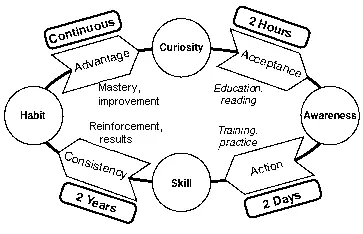I would start by requiring every manager to read Larry
Bossidy and Ram Charan’s excellent book, Execution, the Discipline of Getting Things Done. It focuses on what it takes to build a culture of execution in all areas. One of my favorite quotes from the book is, “Coaching is the single most important part of expanding others capabilities. It’s the difference between giving orders and teaching people how to get things done. Good leaders regard every encounter as an opportunity to coach.”
The key is integrating these new processes, embedding them in every aspect of your culture from management language to forecasting, the sales cycle, and compensation.
How Salespeople Learn: C.A.S.H. Learning Model
Before you can transform your sales force, you have to understand how adults learn. In addition, salespeople learn differently from other adults. In our experience, there are four steps: curiosity, awareness, skill, and habit (see Figure 9–1).

Curiosity
Curiosity is the seed of learning — the individual has to bring this to the table. In our sessions, we always have a mixture of sponges, vacationers, and prisoners. The first two hours are spent getting the prisoners to unfold their arms. They are prisoners of their own experience.
We have to create a gap between where they are and where they need to be to survive and thrive as the demands of selling and the buyer evolve. They need to understand that they must either grow or go.
Awareness
New awareness is important to personal growth. Reading and training are essential. By definition, a system cannot change itself from within. It takes outside forces. But you can’t get competitive advantage from awareness alone. It comes from speed of reaction and execution.
For many people, personal growth and development after college often stagnate or are limited to gaining the skills and knowledge needed to perform their current job. For salespeople, however, the competencies required to perform in today’s market have escalated because they now need to sell to all levels of their client organizations.
Whether a salesperson is a vice president or not, they need to be conversant with and knowledgeable about Clevel issues. However, many salespeople have not developed the necessary strategic literacy in their industries.
Skill
I play golf often and have some skills. I’ve read almost every book on golf, so I have awareness. I birdie some, par some, and have eagled a few. But Tiger Woods does consistently what I do occasionally (I know, he does some things I’ll never do) because he has the discipline to practice incessantly — with his coach — to develop his superior natural physical talents (which I will never have) to their fullest potential. Without this discipline, though, he might be just another trunk slammer, fighting to stay on the tour.
This is also the difference between best-in-class sales organizations and the rest of the pack. The leading sales forces do consistently what others do only some of the time. In the complex sale, the stakes are huge, and the difference between the winner and the loser is often a very close margin.
Habit
Competitive advantage comes with making skills a habit — a permanent, consistent behavioral change at the individual and organizational levels. From awareness to habit is really a two-year process of guided practice.
During the first year, you’re telling them. During the second year, you’re making them realize that this isn’t just the “theme of the month” and that it’s here to stay.
Sometimes salespeople decide to just wait a year until the sales manager either gets fired, taking his new processes with him, or fails to follow up. It will take two years of consistent pressure on your part before all your salespeople are finally convinced that the new process is here to stay.
They will begin to get on board when they see others winning using the process. They will make it a personal habit when the company makes it an organizational habit. Every time you don’t insist on an activity, strategy session, sales plan, principle, or standard, the cloth of discipline begins to tear.
Making It Stick
Greatness can be nothing unless it’s lasting.
Napoléon Bonaparte
An equal challenge is how to make such a process or technology stick with salespeople, who have short attention spans and would rather talk than write. Sales forces have stared down implementations and used passive resistance to outlast scores of multi-million dollar CRM and training initiatives.
Formula for Failure — What Won’t Work
• Declare that, “We have a sales problem.”
• Implement CRM as a fix.
• Hire a big consulting firm to define your sales cycle (be sure to spend seven figures and take a year). Display the results in a large binder.
• Buy what looks or feels good or what came with your new CRM system.
• Pay less than competitive rates to recruiters.
• Make the form or CRM input very comprehensive (i.e., long), and ask everyone for input.
• Run your training at your sales meeting; make sure that it’s the first time your managers have seen it.
• Train your own trainers to save money.
• Hope for adoption, make threats, use guilt, and cheerlead for results.
• Use revenue as the only metric.
• Excuse veterans from compliance.
Management Commitment: They’re Watching You to See If You Are Still Watching Them
This is obvious, of course, but what does it mean? Beyond the customary announcements of top management, it means consistency of execution. Busy salespeople will wait to see if this is just another “theme of the month.”
It may seem unnecessary to emphasize that managers must actually attend and help to lead training sessions, but we have seen organizations where this expectation clearly was not set. Every salesperson is watching his or her manager during any rollout for body language, faint praise, passive resistance, or cynicism.
Every failure by management to reinforce the process will cause the fabric of discipline to begin to tear and competitive advantage to slip away. I once passed one of my managers in the hall and asked him about an action item we had agreed on months earlier. He said, “You don’t forget about these things, do you?” It was one of the best management compliments I ever received.
Fortunately, the new Web-based tools allow managers to see who is actually using the process on a daily basis. The Fort Hill Company, founded by Cal Wick, has built software so that managers can track action item completion and training follow-through by individual, complete with dashboard and graphics.
“You need to check-up periodically and let them know that you are looking. A quick e-mail or some online feedback will put them on notice that you are checking and that you expect execution,” Wick says.
According to Wick:
Up until now, most training programs concentrated exclusively on what happened in the classroom. What happened afterwards was a “black hole.” In fact, what usually happened was something like this: Sales training put on a course to teach new skills and approaches to optimizing the sales process. In the concluding session, attendees were asked to write a goal for applying what they had just learned. They did. Then they put it in their notebooks, put the notebook on the shelf, and went back to doing what they had done before.
Читать дальше













